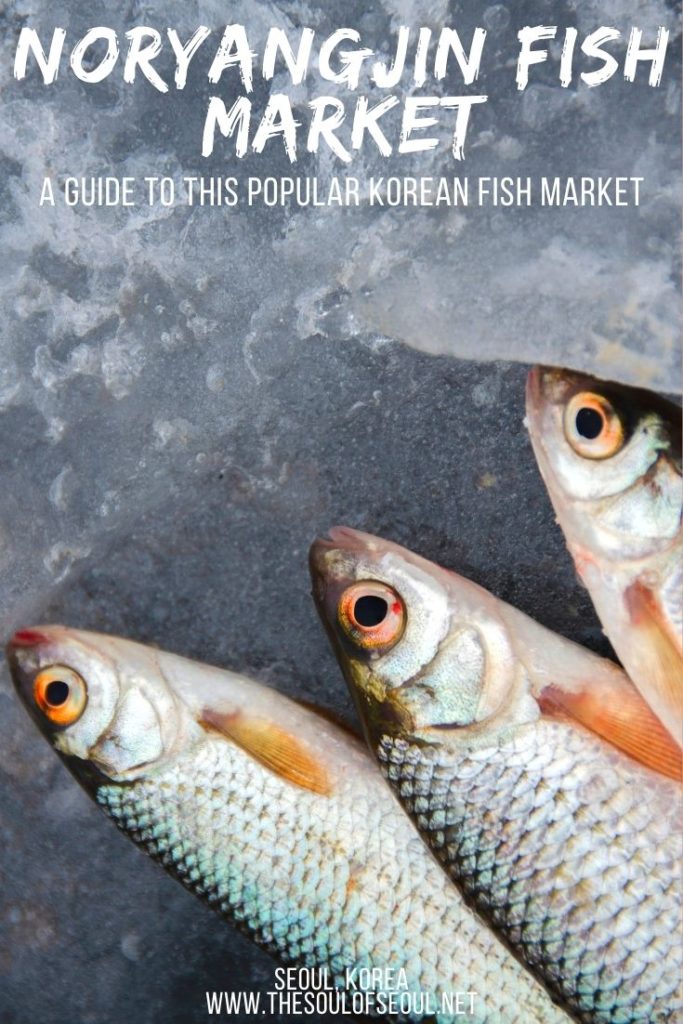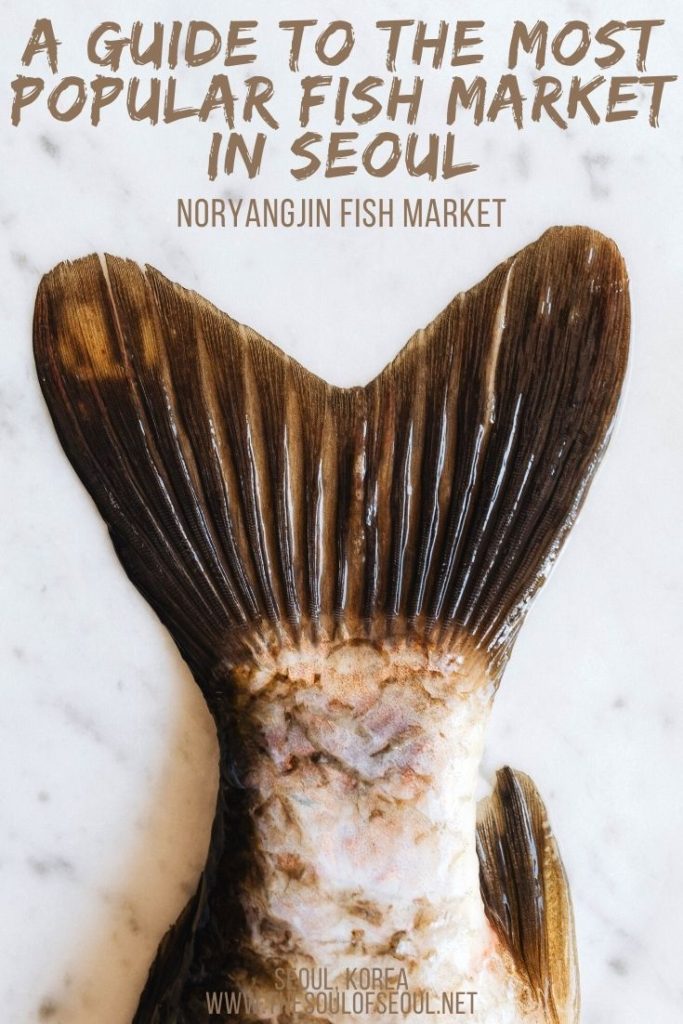Noryangjin Fish Market: A Guide For What To See & What To Order
Last Updated on May 19, 2024
Noryangjin Fish Market (노량진수산물도매시장) is one of top things to see in Seoul. It is the BIGGEST fisheries market in Seoul. Centrally located, Seoul’s most popular fish market is a great spot to check out for lunch or dinner and is great on an itinerary for Seoul but make sure you know what you’re getting into.
Get ready to visit the Noryangjin Fish Market with the names of fish in Korean, the tours to take, and more.

There’s a lot to know about Noryangjin Market. Here’s what to know:
- How To Get To Noryangjin Fish Market
- What To Know
- Go With A Tour Guide
- The Recent History You Should Know
- What To Wear To A Fish Market
- The Fish Market Experience In A Nutshell
- Korean Vocabulary To Know At A Fish Market
- How To Get The Best Price
- What To Do Up In The Restaurant
(This page contains affiliate links. That means if you click on them and purchase something, I will get a percentage of the transaction at no cost to you.)
How To Get To Noryangjin Fish Market
Address: 674 Nodeul-ro, Dongjak-gu, Seoul (서울특별시 동작구 노들로 674 (노량진동))
By Subway: Noryangjin Station is one of hte more confusing stations because there are two stations with the same name and they aren’t connected. BE CAREFUL and note that you need to take the Blue Line, Noryangjin Station, exit 1. There is a new subway station there on Line 9 which is also called Noryangjin Station and it also has it’s own exit 1 for whatever planning reason. If you go on the Line 9, you’ll want to go out of exit 8 and then walk straight to find the entrance to the pedestrian bridge on your left.


What To Know
Operating Hours:
- High Class Fish Market: 24 Hours
- General Fish Market: 1:30am ~ 10:00pm
- Frozen Fish Market: 3:30am ~ 10:00pm
- Shellfish Market: 1:00am ~ 10:00pm
Amenities: restrooms, parking facilities for 1,317 cars, handicap accessible, elevators
Etiquette: Markets can seem loud and like vendors are aggressive. At Noryangjin Market they’re very used to tourists, but that doesn’t mean you should play with or touch the produce. The vendors are looking to sell their seafood and will try to get you to buy, especially if you are close to their stalls and looking closely.
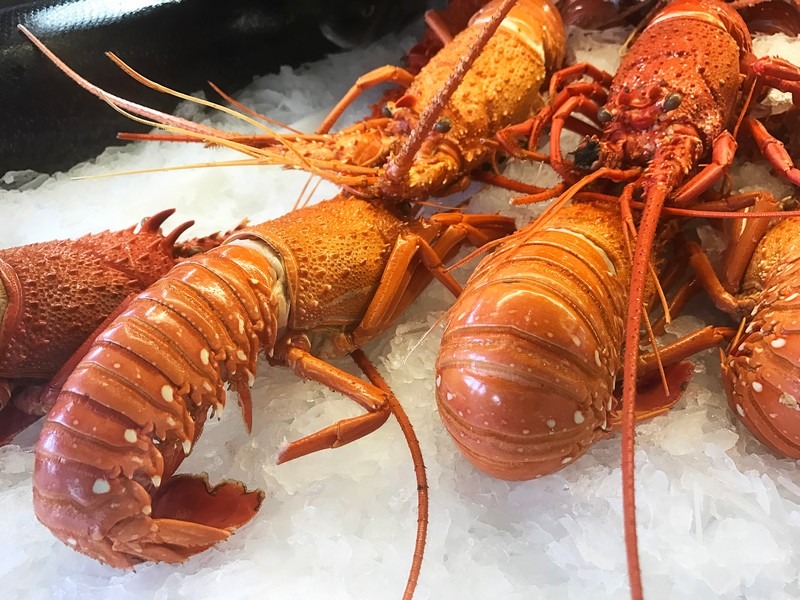
Go With A Tour Guide
There are plenty of places around Seoul I believe tourists and visitors can go on their own, but to be frank, Noryangjin is not one of them unless you have a good handle on Korea and haggling in Korean. All of the major tour websites offer a tour to Noryangjin Fish Market so if you’re booking a variety of tours, add one of these.
- Get Your Guide Noryangjin Fish Market Tour
- Klook Noryangjin Fish Market Tour
- Viator Noryangjin Fish Market Tour

The Recent History You Should Know
Big changes took place in the Noryangjin Fish market area as recently at 2016 and that’s important to note because a lot of information is based off of the old experience. A newly built Noryangjin Fish Market was (un)ceremoniously opened and there was quite a bit of controversy regarding it.
The old market had the classic traditional market vibes and the yellow lights overhead which made things look a little dingy though the produce was just as fresh as in the newer market building.


The newer market has lighting that is whiter and brighter and the paint is stark white so that the fish and seafood really stands out clearly. The restaurants are upstairs and have a more cleaner feeling to eat in which is probably better for tourists though I’ve eaten on both sides and enjoyed the seafood the same.
Go A Bit Further Back
If you want a bit more historical history though, Noryangjin Fish Market first opened in 1927 next to Seoul Station but was moved to its current location in 1971. The market handles about 50% of metropolitan volumes and 250 to 300 tons of marine products are traded every day. WOW!

What To Wear To A Fish Market
This might seem like a weird title to have in this article, but I don’t want anyone being taken by surprise when they realize their nice dress shoes are ruined. Fish markets tend to be pretty wet and in Korean fish markets, the fish are kept living in tanks which means the water is constantly flowing into the tanks and then out through hoses on the ground. Great for the buyer because whether you visit at 7:00am or at 7:00pm, you’ll be getting fresh seafood. However, not so great for your nice shoes.
Also, if you don’t like the feeling of wet toes after walking through a market, you’ll probably want to wear something closed-toe. The newer market is more protected than other outdoor fish markets so luckily you don’t have to worry about the elements as much but do prepared for water.
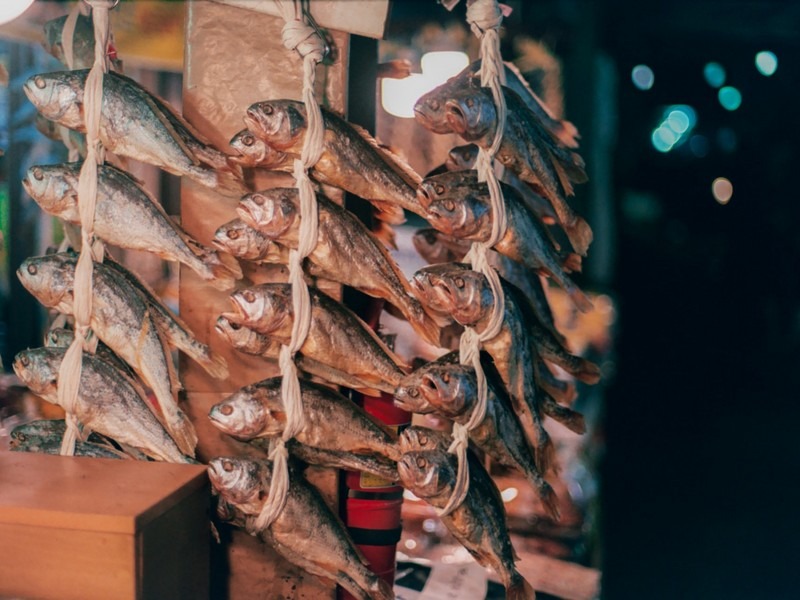
The Fish Market Experience In A Nutshell
The narrow aisles wet down with water that washed away the blood and guts of fish chosen to be eaten lead visitors past the many stalls of fish, shellfish and other ocean edibles. Perched up on Styrofoam shelves or in tanks that seem to be overflowing constantly, the fish glisten and have a tendency to make those with less experience slightly weary of whence they came though I’ve learned often enough that traditional market vendors always have the best food and know what they’re doing.
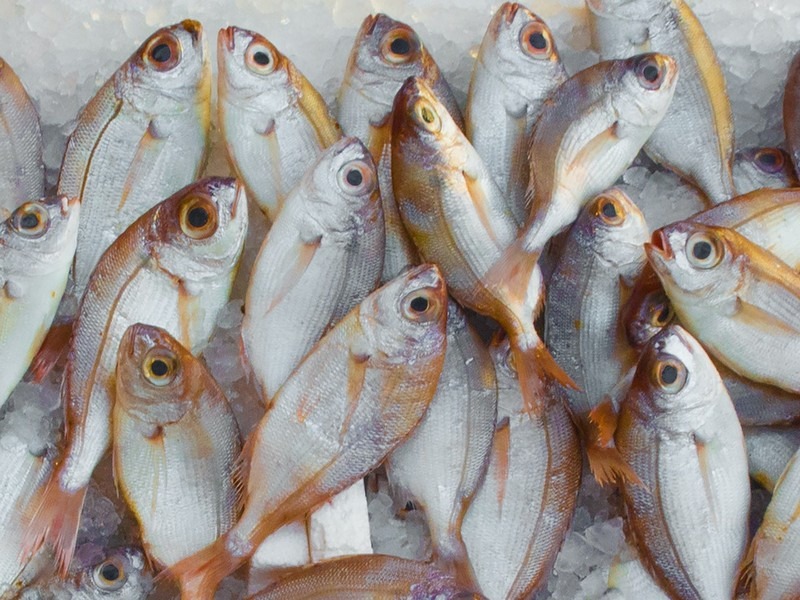
Being married to a guy from Busan, an oceanfront city that is a must see, means that my husband is pretty picky about his seafoody goods. We’re more prone to get fish shipped up to us from his parents than we are to buy it in Seoul and as a Midwesterner from Dayton, Ohio in the States who grew up on meat and only ate the fish her uncle sold from his family owned business, Foremost Seafood, I don’t even know the first thing about picking out anything good. Not to mention that a good portion of the fishy delights here I have never even seen for sale in Ohio. Take this fella right here (pictured below) for example.
Known as hongeo in Korean, it’s skate and if you smell the ammonia odors it emits, you would assume it is not at all edible and yet Koreans enjoy it. Honestly, I’ve tried it and I didn’t hate it but it’s certainly not something I’d ever venture to buy in a fish market on my own. It’s also not something I’d purchase for a first-timer to a Korean fish market.

The market can be hectic and once the vendors get a whiff of a possible sale, they’ll jump on you to make it because they’re basically all selling the same thing and it’s just up to you to decide which person you’ll purchase from. Of special note, if you don’t want to deal with the actual haggle and purchase, all of the vendors are connected to restaurants above so you can just go upstairs and let them know what you want and they’ll get it done for you. Half of the experience, though, is actually buying the fish.
The great thing about purchasing downstairs is that it really is quite fun. Vendors are helpful and interested and highly motivated to help you get what you want whether it be abalone or lobster or something else.
Korean Vocabulary To Know At A Fish Market
So you’re looking to go to the market on your own and figure it out as you go. That’s cool, just make sure you know what you’re ordering. I still manage to get fish vocab confused and just let my husband handle the seafood ordering, but one of these days I’ll get it all to stick in my brain. Here is the Korean vocabulary to help you when you visit a Korean fish market whether you’re in Seoul, Busan, or anywhere in between.

Fish Vocabulary
- Bass: 농어 (nong-uh)
- Flounder: 광어 (gwang-uh)
- Cod: 대구 ( dae-goo)
- Rockfish: 우럭 (ooh-luck)
- Salmon: 연어 (yeon-uh)
- Mackerel: 다랑어 (darang-oh)
- Tuna: 참치 (cham-chi)
- Trout: 송어 (song-uh)
- Carp: 잉어 (eeng-uh)
- Catfish: 메기 (mae-gee)
- Yellowtail: 방어 (bang-oh)
- Sharkfish: 상어 (sang-oh)
- Flatfish: 광어 (gwang-oh)
- Eel: 장어 (jang-uh)
Hweh, Hway, or Hoe (회) is the term for thinly sliced raw fish. It is served fresh on a platter. Unlike sashimi, the Korean version is usually dipped in a red sauce called chojang (초장) and wrapped in different leaves either more salad like leaves, ssam (쌈), or sesame leaves, kketnip (깻잎). There will likely be some gim or laver on the table too. The most common fish for hweh options are salmon, tuna, rockfish, and flounder.


Shellfish & Other Common Finds Vocabulary
- Shrimp: 새우 (sae-ooh)
- Caviar/Roe: 알 (ahl)
- Flying Fish Roe: 나치알 (nal-chi ahl)
- Skate: 홍어 (hong-oh)
- Lobster: 바닷가재 (ba-dat-ga-jae)
- Crab: 게 (gae)
- Live Octopus: 산낙지 (san-nak-ji)
- This is another popular one to have while you’re at a fish market in Korea. The octopus will not be given to you whole… well unless you ask for it that way however that’s extremely dangerous and really Koreans don’t eat it that way. After you buy it, the vendor will cut the tentacles up and when you get it they’ll still be moving though it’s dead and then you eat it.
- Scallops: 가리비 (gah-ri-bi)
- Oysters: 굴 (gool)
- Clams: 조개 (jo-gae)
- Penish Fish/Sea Worms: 개불 (gae-bul)
- This isn’t one that you’ll probably find in other countries, but Koreans LOVE this and I have to say it’s really grown on me. It’s got a bit of a salty taste and once you see it, you’ll known why it has gotten the moniker “penis fish”. While my uncle in the States says American fishermen just throw these back, Korean fishermen saw it and were like, yeah cool, edible. It’s eaten raw and you’ll dip it in some salty sesame oil and it’s rather delightful.
- Sea Cucumbers: 해삼 (hae-sam)
- This is another one I never ate much until I came to Korea but it’s often served WITH the penis fish above so if you get one, get the other. This one is much saltier than the penis fish so it’s usually dipped in the chojang, or sweeter red sauce, on the table.
- Abalone: 전복 (jeon-bok)
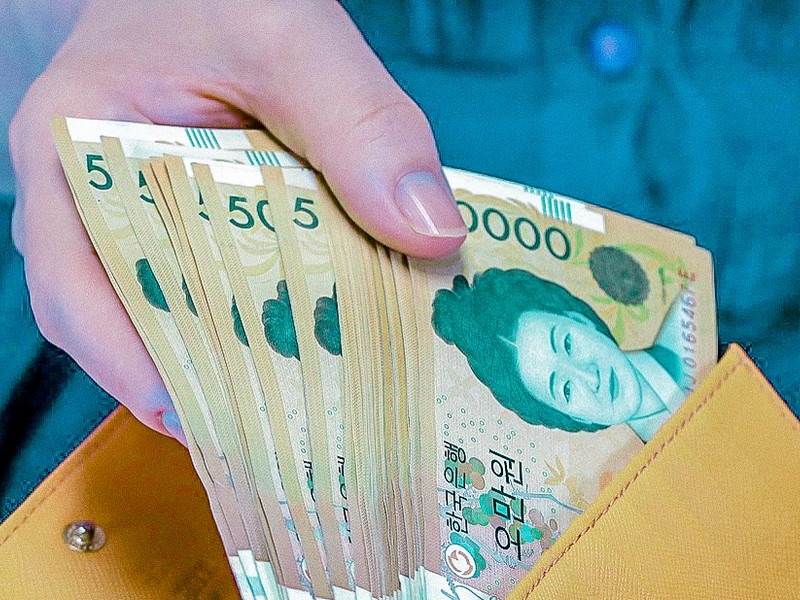
How To Get The Best Price
First off, it’s not cool to walk around, point out fish only to play with them, take pics, and then walk away. Take pics, sure, but don’t play with a vendor’s heart.. or money. That said, they are used to tourists wandering through though they definitely assume at some point, they’ll make a sale so keep that in mind. Items like king crab and lobster can be pretty expensive since they’re imported but a couple small octopus should be around W10,000 and a salmon filet should be around W25,000.
If you’re going for something big like a lobster, be prepared to spend between W50,000 and W80,000 depending on how big it is. Large shrimps usually go for something like 5 for W10,000. The vendors will grab a trusty calculator to help with the bargaining when they think you can’t speak Korean so use that if you need. Also be prepared for vendors to stick to the price but to toss in a few extra shrimp or oysters instead as a sort of service as they say.
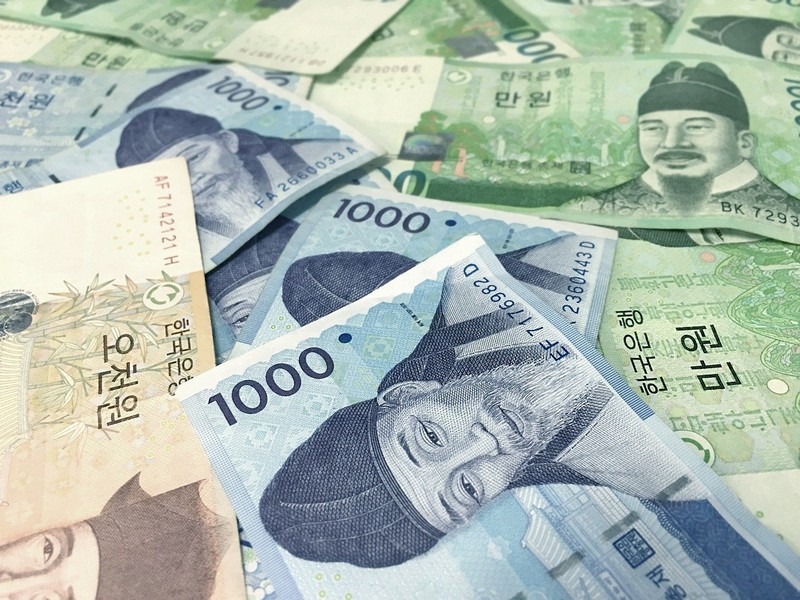
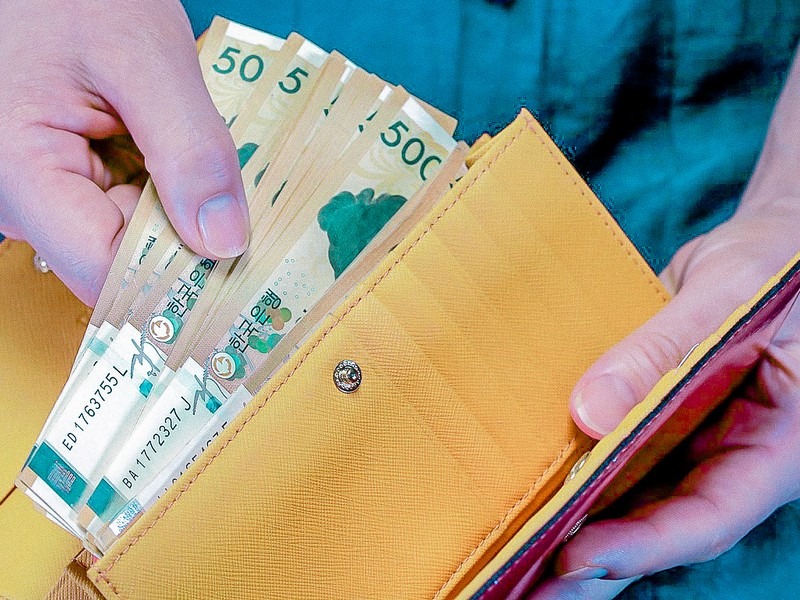
The biggest reason I suggest taking a guide with you is just for the haggling of prices. It is almost like a competitive sport and if you’re unprepared, you can most definitely be taken for a ride. Not all vendors are out to get you by any means, but if you say yes to the first price, you’re just showing the vendors that they can take advantage of naive tourists so don’t be one.
Don’t expect to get a steal of a deal though. In our experience, no matter how much haggling done, it tends to be a more expensive market in general than what we find visiting other local fishy spots.

What To Do Up In The Restaurant
Once you make it to the restaurant, if you ordered all of your fish below yourself, the waiter will ask what you got so they can expect what to make. For shellfish they’ll probably ask you how you want it cooked and you’ll choose between steamed (jjim 찜) or grilled (gwee 구이). Depending on what you’ve bought, you’ll be charged sort of “preparation” fees. It’s not much. It might be W5,000 per person or if you’ve got a big lobster to steam or something it might be an additional W8,000 just for that.
Half way through your meal, you’ll also want to order some sort of soup to complete the meal after your raw or cooked goods from downstairs. One option which is popular is maeuntang (mae-oon-tang) 매운탕 which is a spicy soup made from the bones of your fish and some veg added in. This the most common way to end a meal in a fish restaurant in Korea.
Did you like this post? Pin It!
